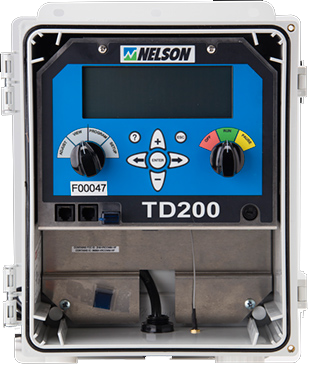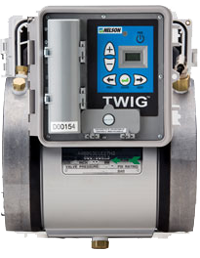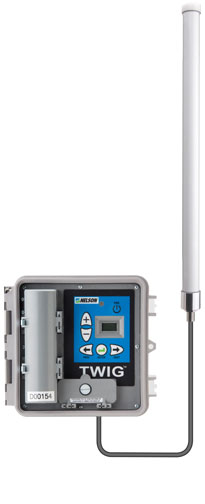TWIG Products

TD200 Controller
The TD200 Controller is an easy to learn and easy to use device that controls TWIGs, either individually or in groups.
- Easy to learn. Easy to use.
- Controls up to 100 TWIGs and 200 valves, individually or in groups, to handle very large systems.
- Reliable, two-way data transfer every 20 seconds.
- Multiple start times with multiple irrigationprograms, easy to set up and use.
- Irrigation events and water meter readings can be data logged.
- Optional power sources: 110 Volt AC, or 12 volt DC battery with solar charger.
- Reads actual battery and radio signal strength of each TWIG in the network.
- TD200 has a factory assigned “network I.D.” that is the network that the TWIGs will join.

TWIG Wireless Control
The TWIG (shown on a 800 Series Control Valve) is central to the wireless system. This device turns low voltage DC latching solenoids on and off at the command of the TD200 Controller.- Turns low voltage DC latching solenoids on and off at the command of the TD200 controller
- Proprietary “Nelson” high powered radio. Adjustable between 902 and 924 MHz.
- Three TWIGs available:
- TWIG-1. Operates one solenoid.
- TWIG-2. Operates two solenoids, independently.
- TWIG-4. Operates up to 4 solenoids, independently.
- Power source: Two D-cell batteries, good for one irrigation season — shipped with TWIG.
- Utilizes a proprietary “deep sleep” cycle technique to minimize power consumption.
- Two antenna options:
- Dua l internal antennas (standard).
- Provides diversity for better reception, and protection from damage. Use where line of site is optimal.
- External antenna (optional). Use to improve signal reception when TWIG does not have good line-of-sight, and to extend range of communication.
- The TWIG is packaged in a rugged, field ready water resistant box. Ag tough!
- Joining a TWIG to a network is effortless and quick, either on setup of a new system, or the addition of a new TWIG to an existing network.
- TWIG is capable of running a manual solenoid test to check solenoid.
- Each TWIG has a factory assigned ID #.

TWIG Repeater
When blind spots or poor communications occur in a network due to vegetation, topography or excessive distances, a repeater can be installed in the network to facilitate communications. The Repeater greatly extends the range of the network and can bridge obstacles that might otherwise block communications.- The “smarts” built into the system automatically direct the radio signal where the signal strength is greatest, i.e. either direct between the TD200 and the Twig, or through the Repeater.
- A Twig network may contain up to 9 repeaters.
- Optional Power Sources: 110Volt AC or 12 Volt DC battery with solar panel.
- Twig Repeaters require an external antenna.
